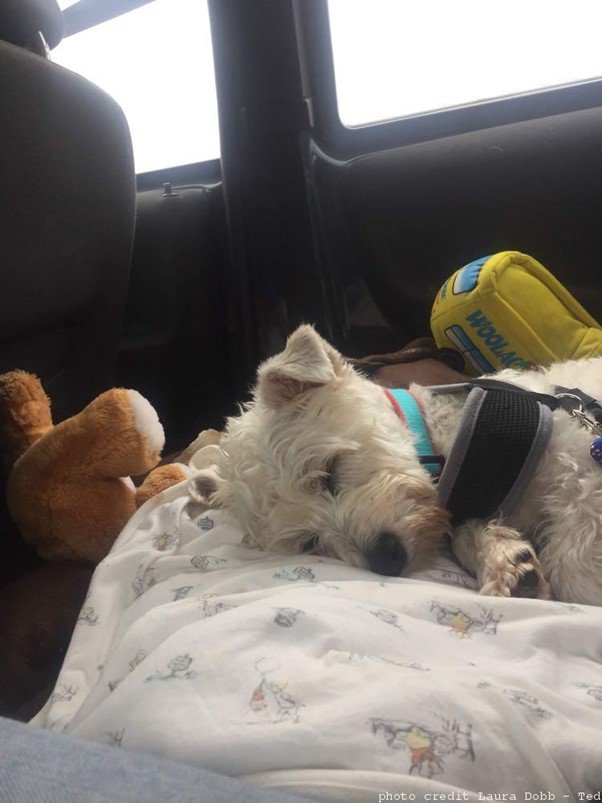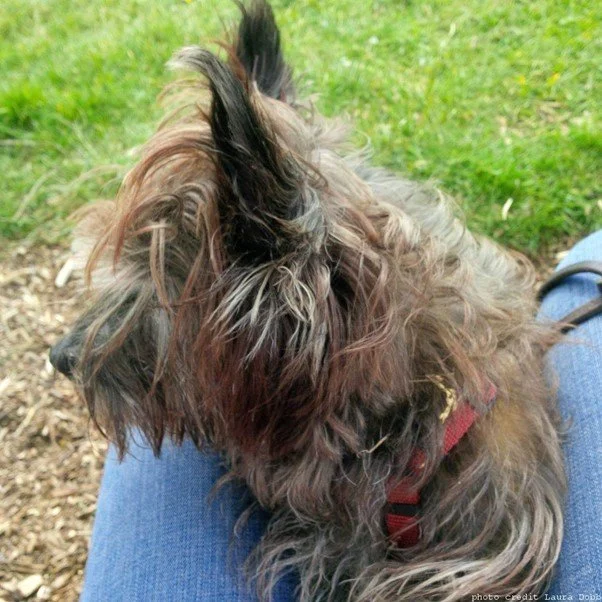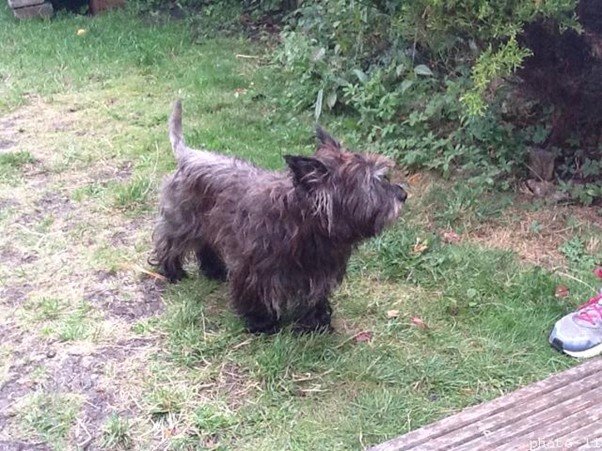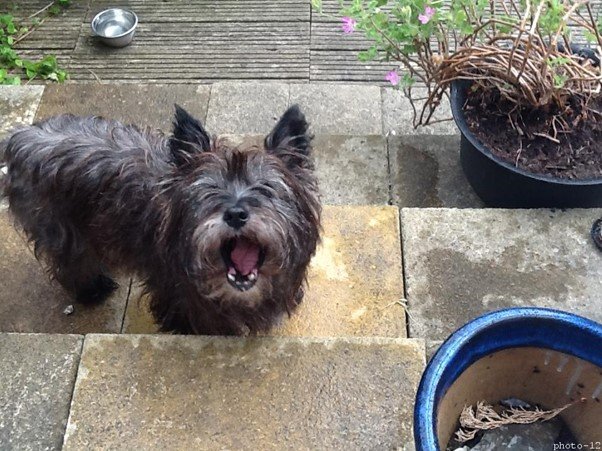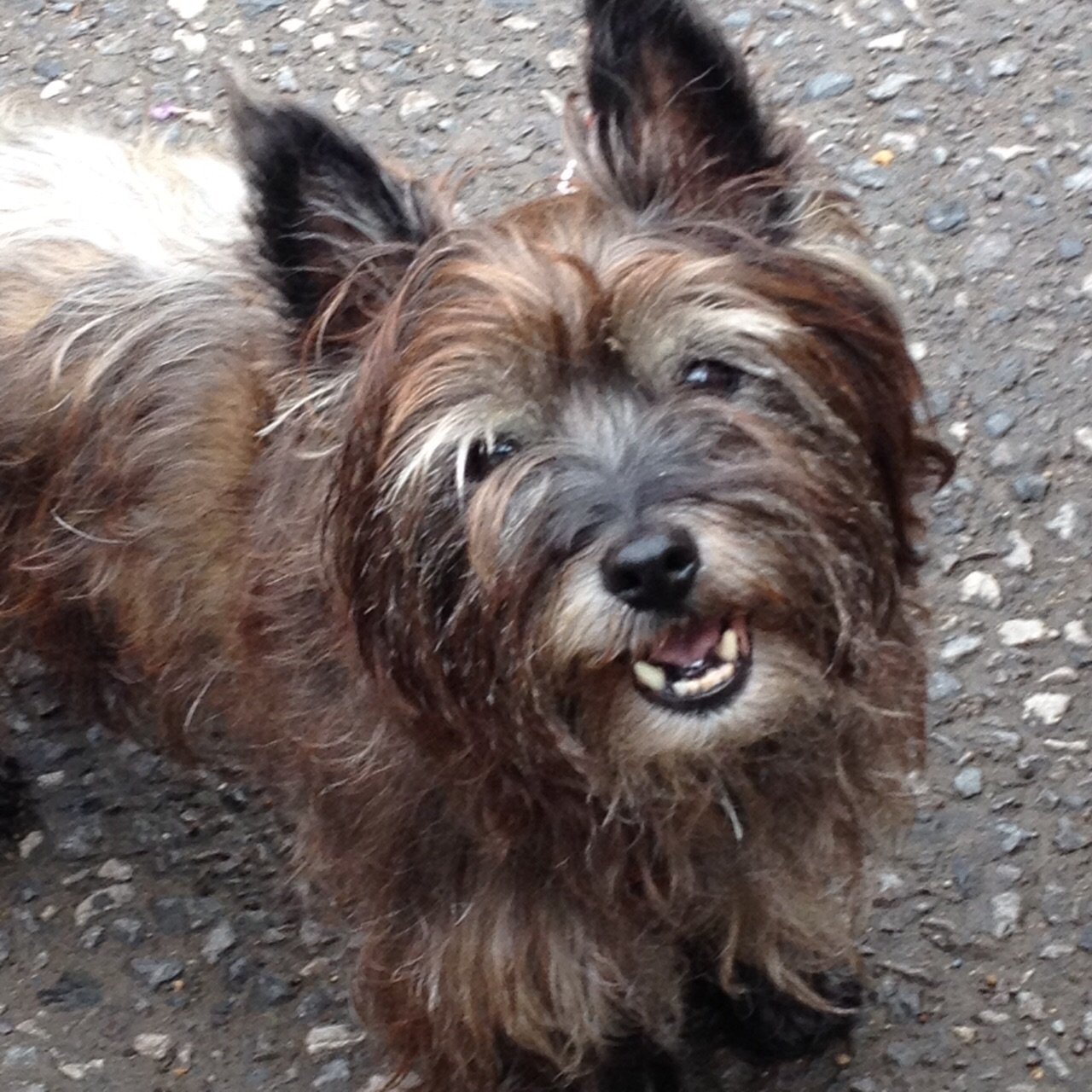The Nash Chronicles
How keeping a diary will help you slow down and learn about your dog
We adopted our ex-breeding dog, Ted, in late February. I guess he’s an official ‘lock down adoptee.’ The adoption was a quick one. One of my clients knew I was looking for a male terrier, and she sent me a photo of Ted. Ted arrived from the North to a Somerset Rescue Centre called Paws4Thought. Well, we all know how powerful photos are! ‘Showing the right thing’ in photos and videos is what the Slow Dog Movement relies upon to share its message. One look at Ted and I was in love.
Photo credit Laura Dobb
My husband and I were on our way up to Durham on the Friday before Dr Amber Batson’s Canine Aggression course. We received a photo of Ted en route. I took Amber’s fabulous course and then we picked up Ted in Somerset on the way back down to Cornwall. The rescue centre wanted a quick turnaround, so we made it happen.
Ted is a two-year-old, neutered, Weechon (Westie x Bichon) male. He had his surgery a couple of weeks before we picked him up. I wouldn’t have neutered him but sometimes these things are out of our hands. Especially with rescue centres in the UK. Because Ted was neutered while in a very fearful state, Ted has retained this nervousness for now. His anxiety also stems from him most likely living in a barn or outbuilding before he came to us. He was likely a puppy farm stud in training. He is afraid of the sound of wind, anything blowing in the wind, men, anything above his head, like clothing or laundry and many other things. If we could move around the house horizontally, he would be much happier.
It’s been over a year since Ted came into our lives. I started a dog enrichment business before lockdown, so I didn’t think to keep a diary to help observe his progress. He has gained confidence and has learned a lot from his house sister dog, Izzy, but now I don’t remember all the details. Keeping a diary, over time, is an excellent way to slow down, observe your dog and create a valuable resource.
photo credit Brett Korteling
We adopted Nash on the 9th November 2013, an ex-breeding dog, from Many Tears Animal Rescue (MTAR) in Wales. I did keep a diary for him. Nash was a seven-year-old neutered Cairn Terrier with a brindle coat. Emily Blackwell, the head of Animal Behaviour at the University of Bristol, used my diary when she helped us with Nash. She said it was ‘incredibily useful!’ We had applied to go on Dogs Their Secret Lives, the TV show in the UK, with Mark Evans. The payment for agreeing to appear on the show was help from Dr Blackwell. This was before I took my International Dog Training Education (IDTE) with Turid Rugaas.
I would never choose to go on TV now, after what I have learned from Turid about dogs and stress. Dr Blackwell’s advice was to cushion our house from noise. We put a tablecloth on our dining table and more rugs on the floors. This helped Nash to relax. Turid’s advice to use the hand signal with Nash proved invaluable. He was resource guarding and biting my husband and sometimes my son. Nash also had separation anxiety. He would try to pull our trouser legs with his teeth when we tried to leave our narrowboat.
Recently, my colleague, Pennie Clayton, posted an article on Facebook about children and parenting that discussed children ‘seeking to connect instead of seeking attention.’ I don’t have the original article to refer to but found plenty online that talks about how ‘Planned ignoring can make an emotionally unmet child even more desperate.’(3) The article goes on to suggest that parents purposefully plan time to spend time with their children, focus their attention on other positive behaviour, be ‘spontaneously’ attentive to [your] child and to not ignore your child as has been the trend in the past. You could replace ‘child’ with ‘dog’ in every sentence above. In fact, the remedy for dogs is the mission statement of the Slow Dog Movement.
We moved from Bristol to a 35 ft narrowboat in Bath in 2014. If you’ve ever had experience with an ex-breeding dog from a puppy farm, you may know already that they are often super sensitive to noise. Nash had spent his seven years before we adopted him, in a pen, probably in a barn. He had never lived in a house or been on a leash besides the slip lead in the shelter. When we went to pick him up at MTAR, they said we could take him for a walk. My husband and I looked at each other and knew that we couldn’t. Nash was so fearful that he was flat on the ground. I couldn’t pull a dog along and wouldn’t. We picked him up and took him ‘for a walk’ away from the reception area. He didn’t pee until we got him home to Bristol. Almost a two-hour drive away!
Looking back over the diary now, I see many details of his behaviour I noted from the moment we met him:
‘On Saturday afternoon, when we brought him home, we tried to make it as calm as possible for him…we had no radio on…for a ten year old boy who was excited about having a new dog, [our son] Henry did very well.
‘I sat beside Nash on his new bed, on the floor of the dining room. I sat there, with my hand beside his torso, all night. He would hear a noise (a pot lid clanging for example), his hear would prick up and he’d lift his head and then he would just lie back down again. By Sunday he rarely lifted his head. He has a sweet habit, if stroked, and while getting himself more comfortable, of groaning in pleasure.’
There are notes about what MTAR fed Nash:
‘they fed him only once, at 07:30 am’ [and what we decided to do]: ‘But we’ve decided to feed him three smaller meals instead.’
Nash had an upset stomach at first, but we switched his food over time. from the high carb kibble to cooked chicken and yam at the beginning. He did very well on this protein high, three meal feeding. It helped him to feel secure and kept his blood sugar on an even keel.’
It is painful to read how shut down Nash was at the beginning. He didn’t know his name. Wouldn’t come to his food bowl. Nash was very worried about going through ‘thresholds’ – like through the doors in our house. We were lucky enough to rent a house with a back garden adjoining the house with a sunroom and French doors. Even though it was November when we adopted our little Cairn, we kept the French doors open for him all the time.
Puppy-mill, breeding dogs stay in one place all their lives. It’s not surprising that they would be afraid of going through doorways. At MTAR, with so many dogs to care for, they corral the dogs out of their pens and into a toileting area a couple times per day. For an already nervous dog, this would only heighten their stress levels. Sometimes, he didn’t want to come back indoors and would make a hole in the soil in the bushes and just sleep there. My husband would sleep on the downstairs settee in that case, so that someone was always there for Nash.
Nash on the narrowboat - photo credit Laura Dobb
A diary entry a few days after Nash came home (all comments in brackets are from original diary entries):
‘Nash was much better today in the garden because (I think this is why?!) I opened the kitchen door and the French doors to the outside and then I just stood and then crouched in the garden. Not moving unless to pick up poop and not speaking. Nash stopped his incessant running or fast paced walking from one end of our 40ft garden up to the door, walking inside sunroom and into kitchen – back and forth – he ended up slowing down. Stopping! Sniffing and then, at the end, as I crouched near the deck, he would walk away and then come up to me, nudge me, let me pat him, over and over. It was a relief.’
Nash got better in some ways – getting used to sounds, going through doors and walking on a leash. But he became more afraid of my husband because of a pairing of events when we first adopted him. Brett had tried to pick up Nash, like he used to pick up our Westie, Bonnie. He tried to do this a few times, out of habit, forgetting that Nash was different to Bonnie.
Brett and I were having an almost silent conflict at the time. Already wary of Brett, Nash picked up on the tension, and started resource guarding me. He had hyper attached to me in the car journey to Bristol and he now would not let Brett near me. Out of desperation, we contacted Dogs Our Secret Lives, the TV Show. We had heard about a chance to be on their show and get free behaviour advice. I have backtracked a bit because I have already said that the hand signal saved us in this situation.
Re-reading the diary has made me realise how much adopted dogs, with limited experience of the world, must cope with. Nash had no depth perception experience. He fell down steps and didn’t know how to climb up or down our terraced house steps at first. Everything was new to him. It’s like being ‘born again’ into a brand-new reality. He had to learn how to jump up and down from the bed and sofa. When Brett or other men were standing or walking, they were scary to Nash, even before the pairing of events. One diary entry, six days after we adopted Nash, on the 15th November entailed a lot of progress for our little Cairn:
‘Nash took some chopped fishy treats from us today. Not from our hands but if I put the in front of him. He is relaxing because he wouldn’t do this before. Slept at the end of our bed last night. Feeling more secure and even will rest beside Brett’s leg or arm.’
On the 18th November, Nash experienced Zoopharmacognosy. He was polite and subdued during the one and half hour session. He preferred the barley greens and spirulina and the olive and rice bran oils. He also chose calendula and green powders. After an hour and a half, he slept. Nash had dental surgery in August 2014. He had eleven extractions and twenty-four stitches:
‘His breath is beautiful, and he no longer pants all the time. We have also started giving Nash anti-anxiety drops (Bach’s Flowers) 3 x day and he is responding very well to these. He even lies down more and rests a lot more during the day…’
We were grateful for Dr Martin Brice’s (Emerson’s Green Vet Surgery in Bristol) help with Nash’s teeth. He told us that small terriers like Nash, and puppy-farm dogs, often inherit congenital issues. When it is their teeth, this can likely mean they also have heart issues as well. It was so obvious to us after the dental surgery, that Nash had been suffering with dental pain for much of his life. This contributed to his behaviour. It makes sense if you think how you feel when you’re in pain! So, after Nash’s dental work, he was much calmer and able to learn things like walking on a loose leash and recall. Before his surgery, this was not possible.
I kept up with Nash’s diary for almost one year, my last entry was the 4th September, 2014. I love about re-reading these early days with Nash. Over the four years we shared our lives with him, he evolved so much. He was a very fearful dog without experience of living with humans or walking on a leash or the world. In the end he was the most amazing communicator with other dogs. He was curious, calm, and loved people and other dogs. He had no separation anxiety because we had used the hand signal. The hand signal had also helped him when he was nervous of men, including the men in my family.
Nash died of congenital congestive heart disease on Easter Monday, 2018. Even though his time with us was short, his life was much improved. He touched our lives in a very deep way.
Last night, I listened to Dr Amber Batson speak about the ‘Importance of Sleep’ with Hannah Capon of Canine Arthritis Management (CAM).[i] Amber suggested the use of a diary as a valuable tool for health concerns. We forget things. It is difficult to catch slower changes if we don’t write them down or keep track in some way. Using our mobile phone camera to shoot mini videos of our dog is also a good way to capture the changes with our dogs. Using both written diary and video would be an ideal combination.
There are a few special dog diaries on the market. You don’t need to spend more than a couple pounds for a cheap blank diary at an office supplies store. I have even used a blank notebook and written the date when I observed my dog. The point is to write often and with loving observation.
Much of us have endured quieter times during the last year, but it doesn’t mean that we are not making ourselves busy. People find it difficult to slow down and create new habits that ease this. The Slow Dog Movement’s mission is to help dog guardians slow down. Carl Honoré’s ‘In Praise of Slow’ book (and his 30 Day’s to Slow Workbook) are excellent resources for humans to start slowing down.[ii] It will help our dogs if we can: stop multi-tasking, take regular ‘nothing’ breaks and leave our gadgets at home more often. Another helpful habit is to learn to move calmly around the house instead of at a frantic pace. Perhaps, grab a hot drink and sit and write some diary entries!
I hope that you enjoy the value of a dog diary and welcome your stories and feedback about this post.
photo credit Sezan Ozgunay


